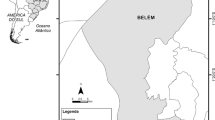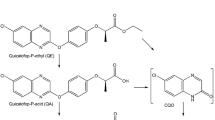Abstract
Soils and sediments are a major sink for lipophilic organic pollutants. The remobilization potential of non-extractable residues is an important aspect of the environmental risk assessment and is directly linked to the binding modes of xenobiotics to macromolecular geopolymers. For instance, weak binding will favour rapid release of toxic metabolites, whereas strong binding will favour release in the long run. So far there is few strong evidence on the precise nature and strength of pollutant binding to organic matter. We used 1,1,1-trichloro-2,2-bis(chlorophenyl)ethane (DDT) contaminated sediment and metalaxyl spiked microbial active soil for alkaline hydrolysis reaction with 18O-sodium hydroxide (Na18OH). Gas chromatography–mass spectrometry analyses showed 2 Da shifts in molecule ions of 2,2-bis(chlorophenyl)acetic acid methylester (DDA-methylester) and additionally in fragment ions of 18O-metalaxyl indicating monolabeled derivatives of both pesticide metabolites.18O-labeling of the carboxyl moiety during hydrolysis proved the cleavage of the metabolites from organic macromolecules. This is the first concrete evidence for stable ester linkage of acidic metabolites of DDT and metalaxyl in soil and sediment matrices.



Similar content being viewed by others
References
Aly MAS, Dautermann WC (1992) Bioavailability, biological activity and characterization of bound residues of fenvalerate in wheat. J Environ Sci Health Part B 27:223–233
Barraclough D, Kearney T, Croxford A (2005) Bound residues: environmental solution or future problem? Environ Pollut 133:85–90
Barriuso E, Benoit P, Dubus IG (2008) Formation of pesticide nonextractable (bound) residues in soil: magnitude, controlling factors and reversibility. Environ Sci Technol 42:1845–1854
Bollag JM, Loll MJ (1983) Incorporation of xenobiotics into soil humus. Experientia 39:1221–1231
Gevao B, Semple KT, Jones KC (2000) Bound pesticide residues in soils: a review. Environ Pollut 108:3–14
Heim S, Schwarzbauer J (2013) Pollution history revealed by sedimentary records: a review. Environ Chem Lett 11:255–270
Kalathoor R, Botterweck J, Schäffer A, Schmidt B, Schwarzbauer J (2015) Quantitative and enantioselective analyses of non-extractable residues of the fungicide metalaxyl in soil. J Soils Sediments 15:659–670
Kronimus A, Schwarzbauer J, Ricking M (2006) Analysis of non-extractable DDT-related compounds in riverine sediments of the Teltow Canal, Berlin, by pyrolysis and thermo-chemolysis. Environ Sci Technol 40:5882–5890
Liu J, Wang Y, Jiang B, Wang L, Chen J, Guo H, Ji R (2013) Degradation, metabolism and bound-residue formation and release of tertrabromobisphenol A in soil during sequential anoxic–oxic incubation. Environ Sci Technol 47:8348–8354
Richnow HH, Seifert R, Hefter J, Kästner M, Mahro B, Michaelis W (1994) Metabolites of xenobiotica and mineral oil constituents linked to macromolecular organic matter in polluted environments. Org Geochem 22:671–681
Riefer P, Klausmeyer T, Schwarzbauer J, Schäffer A, Schmidt B, Corvini PFX (2011) Rapid incorporation and short-term distribution of a nonylphenol isomer and the herbicide MCPA in soil-derived organo-clay complexes. Environ Chem Lett 9:411–415299
Riefer P, Klausmeyer T, Adams A, Schmidt B, Schäffer A, Schwarzbauer J (2013) Incorporation mechanisms of a branched nonylphenol isomer in soil-derived organo-clay complexes during a 180-day experiment. Environ Sci Technol 15:659–670
Schwarzbauer J, Ricking M, Littke R (2003) DDT-related compounds bound to the nonextractable particulate matter in sediments of the Teltow Canal, Germany. Environ Sci Technol 37:488–495
Senesi N (1992) Binding mechanisms of pesticides to soil humic substances. Sci Total Environ 123(124):63–76
Sherma J, Mendoza CE (1973) Chromatographic analysis of pesticide residues. Cr Rev Anal Chem 3:299–354
Author information
Authors and Affiliations
Corresponding author
Rights and permissions
About this article
Cite this article
Kalathoor, R., Zeiner, M., Schmidt, B. et al. First evidence for covalent linkage of acidic metabolites of metalaxyl and DDT as non-extractable pesticide residues in soil and sediment. Environ Chem Lett 13, 431–437 (2015). https://doi.org/10.1007/s10311-015-0514-6
Received:
Accepted:
Published:
Issue Date:
DOI: https://doi.org/10.1007/s10311-015-0514-6




